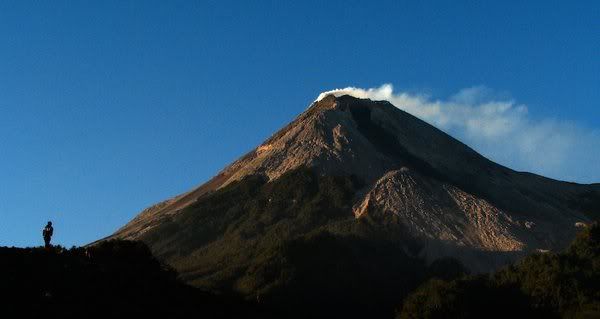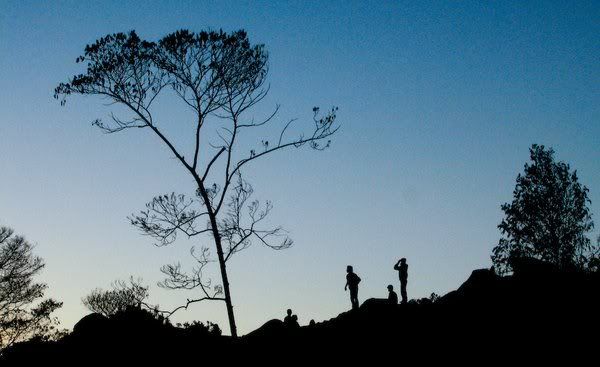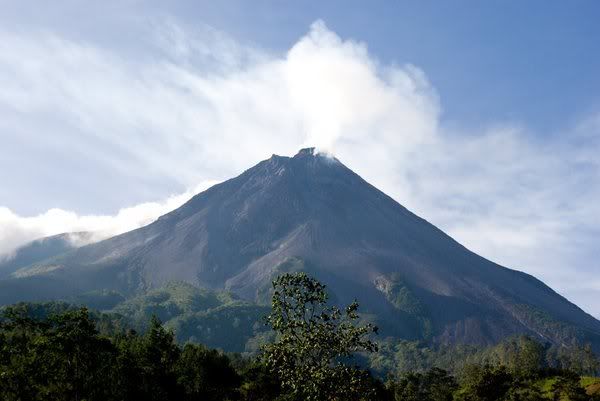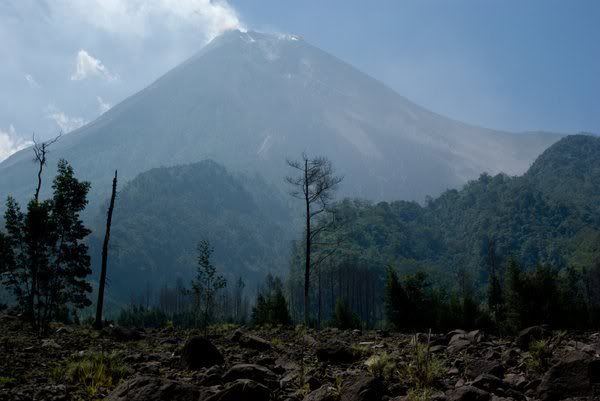Brief Description

The ancient Javanese Hindus built up temples and made Dieng Plateau as a sacred place. The word Dieng word was formed from Sanskrit words Di (Abode) and Hyang (Gods), so Dieng means Abode of the Gods. The Javanese Hindus built hundreds of temples in this place, but only eight are left. The temples were built from 8th century to 13th century by Sanjaya Dynasty and resemble those of Prambanan, but on a smaller scale. The local people named the temples based on the characters in the ancient Javanese Hindu legend which has similarity to famous Hindu story Mahabharata and Ramayana. The Dieng Plateau is a caldera complex formed by the eruption of ancient Mountain Prau. The caldera was once filled up water and then dried up, but volcanic activity continues to this day, with sulphuric fumes and poisonous lakes. Located at an altitude of 2000m, it's also much cooler than the surrounding lowlands.
Long Description
Regions Dieng plateau temple complex is one of the historical attractions are quite famous in Wonosobo regency, Central Java. This plateau is a former volcanic eruptions that formed three craters as well, which Sikidang Crater, Crater Sileri, and Crater Candradimuka. In this highland complex of temples is located.Collection of some temple building was built in the 8th century until the 13th century AD, and is a legacy that Sanjaya Hindu dynasty Shiva. This is proven by the number of relics such as statues of Lord Shiva, Vishnu, Agastya, Ganesha, and others. The temple was built during the 5 centuries, then by the local people are categorized into several groups of temples with names puppet prototype. The names of the group are its temple Arjuna temple, Temple Dwarawati, Candi Gatot Kaca, and Candi Bima. Some of these temples there are also groups that have the small temple with a name that is different also. Day trips to historical sights temples of Dieng complex, at least two things that will be acquired by travelers. First, see the natural beauty of Dieng mountains and breathe the cool fresh air. In these attractions because the air is cool enough to be at an altitude of 6,000 feet or 2093 meters above sea level (asl), so that tourists need not worry about the sun in these tourist sites. No need to also bring a hat, umbrella or other various types of head coverings. Sweat streaming would not be much longer even walk under the blazing sun. Privileges of nature that is the main attraction of this area attractions. Especially when the travelers arrived at the scene in the morning, the first natural scenery that makes travelers were amazed when the sun was rising from the east which is often called the “Golden Sunrise”. Sunlight is emerging from the sidelines of the hills and the light appeared like a glint of gold.
After quite satisfied with this natural scenery, travelers to the beauty of architectural styles along the temples in Dieng mountains. First sight to be seen when the tourists set foot in the mountains Dwarawati Candi Dieng is a group which has one part of the temple named Candi Parikesit. Group of temples located on the Mount The boat is a length of 5 meters, 4 meters wide and 6 meters tall. In each of the outer wall and in the recesses of the temple there is a statue. While on the roof there are small towers are decorated with paintings Simbar Simbar-head. Roof forms and decorations are the influence of the architectural style of South India.
Furthermore, tourists can go on down the group of temple Arjuna. Temple group is divided into two rows of buildings of the temple, there is a row of east-Heroine Arjuna temple, Puntadewa, and Sembadra. While the row of temples on the west there is Candi Semar and Arjuna temple itself. The group is building the temple square and decorated with niches and kala-makara decoration on the walls. Decoration of this temple are most numerous at its peak. Not far from the location of this group of temple Arjuna, tourists also can see some of the former temple, the temple Setyaki, Petruk, Antareja, Nala Gareng, Nakul, and Sadewa. Unfortunately, all the temple was only a foundation and some debris, so that tourists can not see the style of architecture.
Candi Arjuna has a privilege because there is always a stone basin filled with dew water droplets originating from the roof of the temple. Uniquely, the collection of dew water can not be dry even if exposed to hot sun. Unable to dry, then by society and given the name of sacred water of life “Parwito Sari” and believed to contain a blessing for many who use it.
Quite satisfied with enjoying the beauty of the architecture group of temple Arjuna, tourists can go on for a look around the temple architecture of Gatot Kaca measuring 4.5 x 4.5 meters and a square. To get to the location of this temple, visitors must climb the hill Panggonan high enough. However, do not worry about the fatigue that will arise due to go up into these hills, because fatigue would be relieved after seeing the beautiful Lake Kambang Bale is located east of the Temple.
Another temple that is not less interesting and is located at the southernmost position is Candi Bima. To reach this temple travelers would travel as far as 1 km from Candi Gatot Kaca. The temple has a height of about 8 meters, built on the foundation of the square measuring 6 x 6 meters. This temple also has a decoration on the top, as in the group of temple Arjuna. Temple Sikhara shaped (bowl which were held together), is the influence of North Indian style of architecture. While the influence of South Indian architectural styles, there are the trappings of the tower and the recesses of the horseshoe-shaped.
Other privileges, the existence of the Dieng temple is located in the mountains (land), Dieng is considered sacred, because it is a place bersemayamnya Dieng spirits of the gods and goddesses. This is evident from the origin of the word Dieng (Java language) that is the word dhi and hyang. Dhi means mountain, while hyang hyang taken from the word, which means the gods and goddesses. From the origin of the word that was later interpreted as the Dieng mountain where the gods and goddesses who later by the local community is considered sacred ground.
Aside from being a historical attractions, Candi Dieng interesting to visit because it is surrounded by several mountain chains, namely Cleft, Sindoro, Boat, Rogojembangan, and Ben. Various mountain chains are also adding the beautiful natural scenery in this area attractions. From this place, tourists can also see the atmosphere of the City Banjarnegara and Wonosobo city from a height.
If the tourists still want to continue the adventure tourism in the Dieng plateau, there are other attractions are no less interesting, namely Sikidang Crater, Lake Colors, Semar Cave, Tuk Bimalukar, and others.
Temples Complex is located in Mountain Dieng Dieng, Wonosobo regency, Central Java Province, Indonesia. To get to the location of attractions Dieng Temples Complex, travelers can start the journey from the Terminal Wonosobo. From this terminal, take the bus majoring in Wonosobo-Dieng, at a rate of about Rp 7,000 per person to get to the location. The drive from Wonosobo to the Dieng mountain takes approximately 1 hour drive.
The facilities available at these attractions is the prayer room, a place to relax, tourist information centers, and others. There are also food stalls, fruit, toys, and assorted souvenirs. Unfortunately, in the areas surrounding these attractions, there are no hotel facilities. However, if tourists want to spend the night, there were lodging-inn run by people with bathroom facilities and shower in warm water.
Long Description
Regions Dieng plateau temple complex is one of the historical attractions are quite famous in Wonosobo regency, Central Java. This plateau is a former volcanic eruptions that formed three craters as well, which Sikidang Crater, Crater Sileri, and Crater Candradimuka. In this highland complex of temples is located.Collection of some temple building was built in the 8th century until the 13th century AD, and is a legacy that Sanjaya Hindu dynasty Shiva. This is proven by the number of relics such as statues of Lord Shiva, Vishnu, Agastya, Ganesha, and others. The temple was built during the 5 centuries, then by the local people are categorized into several groups of temples with names puppet prototype. The names of the group are its temple Arjuna temple, Temple Dwarawati, Candi Gatot Kaca, and Candi Bima. Some of these temples there are also groups that have the small temple with a name that is different also. Day trips to historical sights temples of Dieng complex, at least two things that will be acquired by travelers. First, see the natural beauty of Dieng mountains and breathe the cool fresh air. In these attractions because the air is cool enough to be at an altitude of 6,000 feet or 2093 meters above sea level (asl), so that tourists need not worry about the sun in these tourist sites. No need to also bring a hat, umbrella or other various types of head coverings. Sweat streaming would not be much longer even walk under the blazing sun. Privileges of nature that is the main attraction of this area attractions. Especially when the travelers arrived at the scene in the morning, the first natural scenery that makes travelers were amazed when the sun was rising from the east which is often called the “Golden Sunrise”. Sunlight is emerging from the sidelines of the hills and the light appeared like a glint of gold.
After quite satisfied with this natural scenery, travelers to the beauty of architectural styles along the temples in Dieng mountains. First sight to be seen when the tourists set foot in the mountains Dwarawati Candi Dieng is a group which has one part of the temple named Candi Parikesit. Group of temples located on the Mount The boat is a length of 5 meters, 4 meters wide and 6 meters tall. In each of the outer wall and in the recesses of the temple there is a statue. While on the roof there are small towers are decorated with paintings Simbar Simbar-head. Roof forms and decorations are the influence of the architectural style of South India.
Furthermore, tourists can go on down the group of temple Arjuna. Temple group is divided into two rows of buildings of the temple, there is a row of east-Heroine Arjuna temple, Puntadewa, and Sembadra. While the row of temples on the west there is Candi Semar and Arjuna temple itself. The group is building the temple square and decorated with niches and kala-makara decoration on the walls. Decoration of this temple are most numerous at its peak. Not far from the location of this group of temple Arjuna, tourists also can see some of the former temple, the temple Setyaki, Petruk, Antareja, Nala Gareng, Nakul, and Sadewa. Unfortunately, all the temple was only a foundation and some debris, so that tourists can not see the style of architecture.
Candi Arjuna has a privilege because there is always a stone basin filled with dew water droplets originating from the roof of the temple. Uniquely, the collection of dew water can not be dry even if exposed to hot sun. Unable to dry, then by society and given the name of sacred water of life “Parwito Sari” and believed to contain a blessing for many who use it.
Quite satisfied with enjoying the beauty of the architecture group of temple Arjuna, tourists can go on for a look around the temple architecture of Gatot Kaca measuring 4.5 x 4.5 meters and a square. To get to the location of this temple, visitors must climb the hill Panggonan high enough. However, do not worry about the fatigue that will arise due to go up into these hills, because fatigue would be relieved after seeing the beautiful Lake Kambang Bale is located east of the Temple.
Another temple that is not less interesting and is located at the southernmost position is Candi Bima. To reach this temple travelers would travel as far as 1 km from Candi Gatot Kaca. The temple has a height of about 8 meters, built on the foundation of the square measuring 6 x 6 meters. This temple also has a decoration on the top, as in the group of temple Arjuna. Temple Sikhara shaped (bowl which were held together), is the influence of North Indian style of architecture. While the influence of South Indian architectural styles, there are the trappings of the tower and the recesses of the horseshoe-shaped.
Other privileges, the existence of the Dieng temple is located in the mountains (land), Dieng is considered sacred, because it is a place bersemayamnya Dieng spirits of the gods and goddesses. This is evident from the origin of the word Dieng (Java language) that is the word dhi and hyang. Dhi means mountain, while hyang hyang taken from the word, which means the gods and goddesses. From the origin of the word that was later interpreted as the Dieng mountain where the gods and goddesses who later by the local community is considered sacred ground.
Aside from being a historical attractions, Candi Dieng interesting to visit because it is surrounded by several mountain chains, namely Cleft, Sindoro, Boat, Rogojembangan, and Ben. Various mountain chains are also adding the beautiful natural scenery in this area attractions. From this place, tourists can also see the atmosphere of the City Banjarnegara and Wonosobo city from a height.
If the tourists still want to continue the adventure tourism in the Dieng plateau, there are other attractions are no less interesting, namely Sikidang Crater, Lake Colors, Semar Cave, Tuk Bimalukar, and others.
Temples Complex is located in Mountain Dieng Dieng, Wonosobo regency, Central Java Province, Indonesia. To get to the location of attractions Dieng Temples Complex, travelers can start the journey from the Terminal Wonosobo. From this terminal, take the bus majoring in Wonosobo-Dieng, at a rate of about Rp 7,000 per person to get to the location. The drive from Wonosobo to the Dieng mountain takes approximately 1 hour drive.
The facilities available at these attractions is the prayer room, a place to relax, tourist information centers, and others. There are also food stalls, fruit, toys, and assorted souvenirs. Unfortunately, in the areas surrounding these attractions, there are no hotel facilities. However, if tourists want to spend the night, there were lodging-inn run by people with bathroom facilities and shower in warm water.










 Read more: http://epg-studio.blogspot.com/2009/06/widget-pengatur-halaman-untuk-kembali.html#ixzz1UA3ocoWT
Read more: http://epg-studio.blogspot.com/2009/06/widget-pengatur-halaman-untuk-kembali.html#ixzz1UA3ocoWT